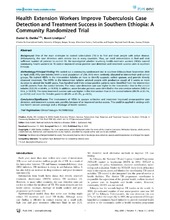| dc.contributor.author | Datiko, Daniel Gemechu | en_US |
| dc.contributor.author | Lindtjørn, Bernt | en_US |
| dc.date.accessioned | 2011-02-22T14:24:22Z | |
| dc.date.available | 2011-02-22T14:24:22Z | |
| dc.date.issued | 2009-05-08 | eng |
| dc.Published | PLoS ONE 4(5): e5443 | en_US |
| dc.identifier.issn | 1932-6203 | |
| dc.identifier.uri | https://hdl.handle.net/1956/4526 | |
| dc.description.abstract | Background: One of the main strategies to control tuberculosis (TB) is to find and treat people with active disease. Unfortunately, the case detection rates remain low in many countries. Thus, we need interventions to find and treat sufficient number of patients to control TB. We investigated whether involving health extension workers (HEWs: trained community health workers) in TB control improved smear-positive case detection and treatment success rates in southern Ethiopia. Methodology/Principal Finding: We carried out a community-randomized trial in southern Ethiopia from September 2006 to April 2008. Fifty-one kebeles (with a total population of 296, 811) were randomly allocated to intervention and control groups. We trained HEWs in the intervention kebeles on how to identify suspects, collect sputum, and provide directly observed treatment. The HEWs in the intervention kebeles advised people with productive cough of 2 weeks or more duration to attend the health posts. Two hundred and thirty smear-positive patients were identified from the intervention and 88 patients from the control kebeles. The mean case detection rate was higher in the intervention than in the control kebeles (122.2% vs 69.4%, p,0.001). In addition, more females patients were identified in the intervention kebeles (149.0 vs 91.6, p,0.001). The mean treatment success rate was higher in the intervention than in the control kebeles (89.3% vs 83.1%, p = 0.012) and more for females patients (89.8% vs 81.3%, p = 0.05). Conclusions/Significance: The involvement of HEWs in sputum collection and treatment improved smear-positive case detection and treatment success rate, possibly because of an improved service access. This could be applied in settings with low health service coverage and a shortage of health workers. | en_US |
| dc.language.iso | eng | eng |
| dc.publisher | Public Library of Science | eng |
| dc.rights | Attribution CC BY | eng |
| dc.rights.uri | http://creativecommons.org/licenses/by/2.0 | eng |
| dc.title | Health Extension Workers Improve Tuberculosis Case Detection and Treatment Success in Southern Ethiopia: A Community Randomized Trial | en_US |
| dc.type | Peer reviewed | |
| dc.type | Journal article | |
| dc.description.version | publishedVersion | en_US |
| dc.rights.holder | Datiko, Lindtjørn | |
| dc.rights.holder | Copyright 2009 Datiko, Lindtjørn | |
| dc.identifier.doi | https://doi.org/10.1371/journal.pone.0005443 | |
| dc.subject.nsi | VDP::Medical disciplines: 700::Clinical medical disciplines: 750::Communicable diseases: 776 | eng |
| dc.subject.nsi | VDP::Medical disciplines: 700::Clinical medical disciplines: 750::Lung diseases: 777 | eng |

